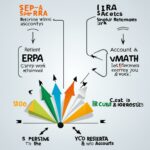Hello, I’m here to provide you with essential information about SEP IRA contribution limits for 2024 and 2024. If you’re seeking to maximize your retirement savings and take advantage of tax benefits, understanding the contribution limits is crucial. Let’s dive in!
Contributions that an employer can make to an employee’s SEP IRA are subject to specific limits set by the IRS. The maximum amount an employer can contribute is the lesser of 25% of the employee’s compensation or $66,000 for 2024 ($61,000 for 2024, $58,000 for 2024, and $57,000 for 2020). It’s important to note that elective salary deferrals and catch-up contributions are not permitted in SEP plans. Additionally, participants in SARSEP plans established before 1997 have different contribution limits.
Key Takeaways:
- SEP IRA contribution limits for 2024 and 2024 are based on the employee’s compensation or net earnings from self-employment.
- The employer’s contributions to employees’ SEP IRAs cannot exceed 25% of their compensation or the annual limit set by the IRS.
- Elective salary deferrals and catch-up contributions are not allowed in SEP plans.
- Participants in SARSEP plans established before 1997 have different contribution limits.
- Understanding and adhering to the contribution limits is crucial for effective retirement planning and maximizing tax benefits.
SEP IRA Eligibility Rules
When considering participation in an employer’s SEP IRA, it’s important to understand the eligibility rules. These rules dictate who can contribute to and benefit from a SEP IRA. To qualify, individuals must meet certain criteria:
- Age Requirement: Participants must be at least 21 years old.
- Work History: Employees must have worked for the business for at least three of the past five years.
- Minimum Earnings: Individuals must have earned at least $650 from the job in 2024.
Employers have the flexibility to set less restrictive eligibility rules if they choose. This may include enrolling newly hired employees or imposing additional requirements. However, it’s crucial that these rules are uniform and apply to all employees in a fair and consistent manner.
Meeting the eligibility criteria ensures that individuals can take advantage of the benefits and retirement savings opportunities provided by a SEP IRA. By adhering to these rules, employees can start building their nest egg and securing their financial future.
SEP IRA Tax Deductions
When it comes to saving for retirement, one of the key benefits of a SEP IRA is the potential for tax deductions. Contributions made to a SEP IRA are tax-deductible, providing a valuable advantage for both employers and employees.
For employers, the ability to deduct SEP IRA contributions can help reduce taxable income, lowering their overall tax liability. This can result in significant savings and provide an incentive for employers to offer SEP IRA plans as part of their employee benefits package.
Employees also benefit from SEP IRA tax deductions. By contributing to a SEP IRA, employees can reduce their taxable income for the year, potentially lowering their tax bracket and overall tax bill. This means more money in their pocket and more opportunities for long-term savings and investment growth.
How SEP IRA Tax Deductions Work
SEP IRA tax deductions are subject to certain limits and guidelines. Employers can deduct contributions made to their employees’ SEP IRA accounts, up to the lesser of 25% of the employee’s compensation or a specified dollar limit set by the IRS. The specific dollar limit varies each year, so it’s important to stay updated with the latest IRS guidelines.
As an employer, it’s essential to understand the rules and regulations surrounding SEP IRA tax deductions to ensure compliance and maximize the benefits for both your business and your employees. Consulting with a tax professional or financial advisor can provide valuable guidance and help you navigate the intricacies of SEP IRA tax deductions.
The Benefits of SEP IRA Tax Deductions
SEP IRA tax deductions offer several advantages for employers and employees:
- Tax savings: SEP IRA contributions reduce taxable income, resulting in potential tax savings for both employers and employees.
- Retirement savings: With the ability to lower their tax liability, employees can allocate more funds toward their SEP IRA, boosting their retirement savings.
- Employee incentives: Offering a SEP IRA plan with tax-deductible contributions can be an attractive benefit for employees, helping to attract and retain top talent.
SEP IRA Contribution Rules
When it comes to SEP IRAs, the contribution rules are quite straightforward. Unlike other retirement plans, SEP plans only allow for employer contributions. However, there are specific guidelines for self-employed individuals as well.
For self-employed individuals, contributions to a SEP IRA are limited to 25% of their net earnings from self-employment. This ensures that self-employed individuals have the opportunity to save for retirement based on their income. In 2024, the maximum contribution for self-employed individuals is $61,000 ($58,000 for 2024).
Similarly, contributions made by employers for their employees are subject to the same limits. Whether you’re a business owner or an employee, the contribution rates should be uniform for all eligible employees of a company with a SEP IRA plan. This ensures fairness and equal opportunities for retirement savings.
Understanding the contribution rules is crucial to effectively plan and maximize your retirement savings. Whether you’re self-employed or part of a company with a SEP IRA plan, knowing the limits and following the rules will help you make the most of this retirement savings option.
| Contribution Type | Contribution Limit |
|---|---|
| Self-Employed Individuals | $61,000 (2024) $58,000 (2024) |
| Employer Contributions | $61,000 (2024) $58,000 (2024) |
By adhering to the SEP IRA contribution rules, you can ensure that you’re on the right track to secure your financial future in retirement. Keep in mind that these limits may change annually, so it’s essential to stay updated on the latest guidelines from the IRS.
SEP IRA Limits Calculation
Calculating the maximum annual contribution limit for a SEP IRA is crucial for effective retirement planning. The contribution limit is determined based on either the employee’s compensation or their net earnings from self-employment. It is important to understand how the calculation works to ensure compliance with IRS guidelines and maximize savings for the future.
For employees, the contribution to a SEP IRA cannot exceed 25% of their compensation. This means that if an employee’s compensation is $50,000, the maximum contribution they can make to their SEP IRA would be $12,500 (25% of $50,000).
On the other hand, for self-employed individuals, the contribution limit is based on their net earnings from self-employment. Let’s say a self-employed individual has a net earnings of $60,000 for the year. The maximum contribution they can make to their SEP IRA would be $15,000 (25% of $60,000).
It is important to note that there is an annual limit set by the IRS which caps the maximum contribution to a SEP IRA. For example, in 2024, the limit is $61,000. Therefore, even if the calculated contribution based on compensation or net earnings is higher than $61,000, the actual contribution cannot exceed this limit.
Understanding the SEP IRA limits calculation is crucial for individuals and businesses alike. By correctly calculating and adhering to the contribution limits, individuals can maximize their retirement savings while enjoying the tax advantages offered by SEP IRAs.
| Year | SEP IRA Contribution Limit |
|---|---|
| 2020 | $57,000 |
| 2024 | $58,000 |
| 2024 | $61,000 |
| 2024 | $66,000 |
As seen in the table above, the SEP IRA contribution limit has been increasing over the years, allowing individuals to save more for their retirement. It is essential to stay updated with the latest limit set by the IRS to ensure compliance and take full advantage of the opportunities presented by SEP IRAs.
Self-Employed SEP IRA Contribution
As a self-employed individual, you have the opportunity to contribute to your own SEP IRA, allowing you to save for retirement and enjoy tax benefits. Your contribution to the SEP IRA is based on your net earnings from self-employment. The IRS limits this contribution to 25% of your net earnings, up to the annual limit.
By contributing to your SEP IRA, you not only secure your financial future but also reduce your taxable income. This means that you can save for retirement while potentially lowering your tax liability, making it a win-win situation.
It’s important to note that the annual limit for self-employed SEP IRA contributions may change each year based on IRS regulations. As a responsible self-employed individual, staying updated on these contribution limits can help you make informed decisions about your retirement savings.
The Benefits of Self-Employed SEP IRA Contributions:
- Tax Advantages: Contributing to your SEP IRA allows you to take advantage of tax deductions. By reducing your taxable income, you can potentially lower your tax bill.
- Flexible Contributions: With the ability to contribute up to 25% of your net earnings, you have the flexibility to adjust your contributions based on your income and financial goals.
- Retirement Savings: By contributing regularly, you can build a substantial nest egg for your retirement, providing you with financial security and peace of mind.
- Investment Growth: Your SEP IRA contributions can be invested in a variety of assets, allowing your savings to grow over time. This can help you achieve long-term financial goals and combat the effects of inflation.
Remember, contributing to your SEP IRA not only benefits your financial future but also demonstrates your commitment to securing a comfortable retirement. Take advantage of this valuable opportunity as a self-employed individual to save for the retirement you deserve.

SEP IRA vs 401k
When it comes to retirement savings, two popular options to consider are SEP IRAs and 401(k) plans. While both offer valuable ways to secure your financial future, understanding their differences can help you make the right choice for your individual circumstances.
SEP IRAs are often favored by self-employed individuals and small businesses, while 401(k) plans are more commonly found in larger companies. Let’s take a closer look at some key factors to consider when comparing SEP IRAs and 401(k) plans.
Contribution Limits
One important aspect to consider is the contribution limits. SEP IRAs have higher contribution limits compared to 401(k) plans, allowing individuals to save more for retirement. The maximum contribution for 2024 is $61,000 for a SEP IRA, while 401(k) plans have a maximum contribution limit of $19,500 for individuals under 50 years old.
However, it’s important to note that 401(k) plans offer an additional catch-up contribution option for individuals aged 50 and older, allowing them to contribute an extra $6,500 in 2024. This catch-up contribution is not available in SEP IRAs.
Eligibility and Employer Contributions
SEP IRAs have more flexible eligibility requirements, making them suitable for self-employed individuals and small businesses of any size. The eligibility rules for a SEP IRA typically require employees to be at least 21 years old and to have worked for the employer for three of the past five years.
On the other hand, 401(k) plans often have more stringent eligibility requirements, and they are typically offered to employees of larger companies. These plans may also come with employer matching contributions, which can provide additional retirement savings.
Investment Options
Both SEP IRAs and 401(k) plans offer a wide range of investment options, allowing individuals to tailor their portfolio to their risk tolerance and financial goals. Whether you prefer stocks, bonds, mutual funds, or other investment vehicles, both retirement plans provide the flexibility to choose the investments that align with your investment strategy.
Employer Responsibilities
While both SEP IRAs and 401(k) plans have advantages, it’s important to consider the administrative responsibilities that come with each. SEP IRAs have lower administrative costs and simpler setup processes, making them attractive options for self-employed individuals and small business owners.
On the other hand, 401(k) plans require more administrative duties and may involve additional costs for larger businesses. Employers offering a 401(k) plan must comply with certain regulations, including annual nondiscrimination testing and Form 5500 filings.
Table – SEP IRA vs 401k Comparison
| SEP IRA | 401(k) Plan | |
|---|---|---|
| Contribution Limits | $61,000 (2024) | $19,500 (under 50) |
| Additional Catch-up Contribution | No | $6,500 (age 50 and older) |
| Eligibility Requirements | Flexible | Often more stringent |
| Employer Matching Contributions | No | Commonly available |
| Administrative Responsibilities | Lower costs, simpler setup | More administrative duties, potential costs |
Overall, the choice between a SEP IRA and a 401(k) plan depends on your specific needs and circumstances. Self-employed individuals and small business owners often find SEP IRAs to be more advantageous, while larger companies may prefer the benefits offered by 401(k) plans. Considering factors such as contribution limits, eligibility requirements, investment options, and employer responsibilities can help you make an informed decision for your retirement savings.
SEP IRA Max Contributions
When planning for retirement, it’s important to understand the maximum annual contributions allowed for your SEP IRA. In 2024, the maximum contribution limit for self-employed individuals and small businesses is $61,000. This limit includes both employer contributions and employee contributions.
By contributing the maximum amount to your SEP IRA, you can take advantage of the tax benefits and build a substantial retirement savings. However, it’s crucial to note that the contribution limits are subject to change each year based on regulations set by the IRS.
Contributing the maximum allowed amount to your SEP IRA can provide you with peace of mind and ensure that you’re taking full advantage of this retirement savings vehicle. It’s always a good idea to consult with a financial advisor to determine the best contribution strategy for your specific circumstances.

By maximizing your contributions to your SEP IRA, you can take proactive steps towards a secure and comfortable retirement. Start planning today to make the most of your retirement savings opportunities.
SEP IRA Contribution Deadline
When it comes to contributing to a SEP IRA, it’s essential to be aware of the contribution deadline. Meeting this deadline ensures that you can make the most of the tax advantages and save for your retirement effectively. The contribution deadline for a SEP IRA is aligned with the tax filing deadline, including any extensions you may have filed.
For most individuals, the deadline to make SEP IRA contributions is April 15th of the following tax year. This gives you time to assess your financial situation and determine the amount you can contribute towards your retirement savings. By making contributions by this deadline, you can also take advantage of potential tax deductions.
Self-employed individuals, however, have a bit more flexibility. If you filed an extension for your tax return, the deadline for making SEP IRA contributions is extended as well. For those who filed an extension, the new deadline is October 15th of the following year.
Meeting the SEP IRA contribution deadline is crucial for ensuring that you can save for retirement and take advantage of the tax benefits associated with these accounts. By contributing on time, you can maximize your retirement savings and enjoy a financially secure future.
SEP IRA Rules for SARSEP Plans
SARSEP plans, established before 1997, have different contribution rules compared to SEP IRAs. Participants in SARSEP plans can make elective salary deferral contributions, with limits set at $22,500 in 2024 ($20,500 in 2024). Catch-up contributions are not subject to this limit. The overall contribution limit, excluding catch-up contributions, is the same as the SEP IRA limit.

SARSEP plans offer participants the flexibility to contribute a portion of their salary toward retirement savings, providing potential tax advantages. These plans were popular before the introduction of the SIMPLE IRA and continue to be available to those who established them before 1997.
Contributions made by participants in SARSEP plans are conveniently deducted from their salary, reducing their taxable income and helping them build retirement savings. However, it’s important to note that SARSEP plans have certain limitations compared to SEP IRAs.
Contributions and Limits
In SARSEP plans, eligible participants can make elective salary deferral contributions. For 2024, the annual limit for these contributions is $22,500 ($20,500 in 2024). Catch-up contributions for participants who are 50 years old or older are not subject to this limit, allowing them to save even more.
It’s essential to keep in mind that the overall contribution limit for SARSEP plans, excluding catch-up contributions, is the same as the SEP IRA limit. This means that employers can contribute up to the lesser of $66,000 or 25% of the employee’s compensation for 2024, while participants can make elective salary deferral contributions up to the limit.
Summary of SEP IRA Rules for SARSEP Plans
Here is a summary of the key rules and contribution limits for SARSEP plans:
| Plan Type | Establishment Year | Contributions | Limits |
|---|---|---|---|
| SARSEP | Before 1997 | Elective Salary Deferral Contributions | $22,500 in 2024 ($20,500 in 2024) (Catch-up contributions not subject to limit) |
| SEP IRA | Anytime | Employer Contributions | Up to the lesser of $66,000 or 25% of employee’s compensation |
SEP IRA Contribution Limits for SIMPLE IRA Plan
When it comes to retirement savings, it’s important to understand the contribution limits for different types of accounts. In the case of a SIMPLE IRA plan, the contribution limits are separate from those of a SEP plan. Let’s take a closer look at the contribution limits for a SIMPLE IRA plan:
Employee Contributions
Employees participating in a SIMPLE IRA plan have their own contribution limits. In 2024, the maximum employee contribution is $14,000 ($13,500 in 2020-2024). Additionally, individuals aged 50 and older can make catch-up contributions of up to $3,000 on top of their regular contributions.
Employer Contributions
Employer contributions to a SIMPLE IRA plan are subject to different rules. The employer is required to make either a matching contribution or a non-elective contribution. A matching contribution is based on the employee’s salary deferral contributions, up to a maximum of 3% of the employee’s compensation. Alternatively, the employer can choose to make a non-elective contribution of 2% of each eligible employee’s compensation, regardless of whether the employee contributes to the plan or not.
Here’s a table summarizing the contribution limits for a SIMPLE IRA plan:
| Contribution Type | Maximum Contribution |
|---|---|
| Employee Contribution | $14,000 in 2024 ($13,500 in 2020-2024) + $3,000 catch-up contribution for individuals aged 50 and older |
| Employer Contribution (matching) | Up to 3% of employee’s compensation |
| Employer Contribution (non-elective) | 2% of each eligible employee’s compensation |
Understanding the contribution limits for a SIMPLE IRA plan is crucial for individuals and businesses looking to maximize their retirement savings. It’s important to consult with a financial advisor or tax professional to ensure compliance with IRS regulations and make the most of these retirement savings opportunities.
SEP IRA Contribution Limits Compared to Traditional IRA
When it comes to retirement savings, it’s crucial to understand the contribution limits for different types of Individual Retirement Accounts (IRAs). In this section, we’ll compare the contribution limits of SEP IRAs and Traditional IRAs, highlighting the advantages of SEP IRAs for long-term financial planning.
SEP IRAs offer significantly higher contribution limits compared to Traditional IRAs, making them an attractive option for individuals looking to maximize their retirement savings. For the year 2024, the maximum contribution to a SEP IRA is $61,000, while Traditional IRAs have a limit of $6,000 for individuals under 50 and $7,000 for individuals 50 and older, with an additional catch-up contribution. This substantial difference in contribution limits allows SEP IRA holders to save more for their retirement years.”
| IRA Type | Contribution Limits (2024) | Catch-Up Contribution (50 and older) |
|---|---|---|
| SEP IRA | $61,000 | N/A |
| Traditional IRA | $6,000 | $1,000 |
As seen in the table above, SEP IRAs provide individuals with the opportunity to contribute a significantly higher amount towards their retirement savings compared to Traditional IRAs. This can greatly benefit individuals who have the financial means and desire to save for their future.
It’s important to note that SEP IRAs are primarily designed for small business owners and self-employed individuals, while Traditional IRAs are available to all individuals, regardless of employment status. However, the higher contribution limits of SEP IRAs make them an attractive choice for those who have the opportunity to contribute larger amounts towards their retirement funds.
With the ability to contribute more to a SEP IRA, individuals can take advantage of the potential for greater tax-deferred growth and build a more substantial retirement nest egg. Additionally, SEP IRA contributions may be tax-deductible, providing further tax benefits for participants.
In the next section, we will explore the benefits of SEP IRA plans, highlighting the advantages they offer in terms of ease of establishment, lower administrative costs, and tax deductions.

Benefits of SEP IRA Plans
When it comes to retirement planning, SEP IRA plans offer a multitude of benefits that make them an excellent choice for small business owners and self-employed individuals. Let’s take a closer look at some of the key advantages:
Easier Establishment
Setting up a SEP IRA is relatively simple compared to other retirement plans. There are no complex administrative requirements or costly setup fees involved. With just a few straightforward steps, you can establish your SEP IRA and start saving for your future.
Lower Administrative Costs
SEP IRA plans are known for their cost-effectiveness. Unlike some other retirement plans that may come with high administrative fees, SEP IRAs typically have lower costs. This makes them a more affordable option, especially for small business owners who want to provide retirement benefits to their employees.
Tax-Deductible Contributions
One of the significant advantages of SEP IRA plans is the ability to make tax-deductible contributions. As a business owner, you can deduct your SEP IRA contributions from your taxable income, reducing your overall tax liability. This allows you to save for retirement while potentially lowering your current tax obligations.
Opportunity for Increased Savings
SEP IRAs offer self-employed individuals the opportunity to save more for retirement compared to traditional IRAs. With a higher contribution limit of up to $61,000 for 2024, self-employed individuals can maximize their retirement savings potential and build a more substantial nest egg for their future.
To further illustrate the benefits of SEP IRA plans, here’s a comprehensive table comparing SEP IRAs to other retirement plans:
| Benefits | SEP IRA | Traditional IRA | 401(k) |
|---|---|---|---|
| Tax-deductible contributions | Yes | Yes | Yes |
| Contribution limit (2024) | $61,000 | $6,000 ($7,000 for 50+) | $19,500 ($26,000 for 50+) |
| Employer contributions | Yes | No | Yes |
| Eligibility for self-employed | Yes | Yes | No |
As you can see from the table, SEP IRAs offer a unique combination of tax benefits, higher contribution limits, and employer contribution options, making them an attractive choice for retirement savings.
Conclusion
Understanding the SEP IRA contribution limits is crucial for individuals and businesses alike when planning their retirement savings. By adhering to these limits, maximizing tax deductions, and taking advantage of the benefits offered by SEP IRAs, you can effectively save for your future and ensure a financially secure retirement.
SEP IRAs provide a valuable opportunity to set aside a significant amount of money for retirement. With contribution limits up to $61,000 for self-employed individuals and small businesses, SEP IRAs allow you to save more compared to traditional IRAs. This higher contribution limit can make a substantial difference in your long-term retirement savings.
In addition to the higher contribution limits, SEP IRAs come with other benefits. Contributions are tax-deductible, reducing your taxable income and providing potential savings. SEP IRAs also have lower administrative costs compared to other retirement plans, making them a cost-effective option for individuals and businesses.
By understanding and maximizing the benefits of SEP IRA plans, you can take control of your retirement savings. Whether you’re a self-employed individual or a small business owner, the SEP IRA offers a powerful tool to secure your financial future. Start planning today, and make the most of your retirement savings potential.
FAQ
What are the contribution limits for SEP IRA in 2024 and 2024?
The maximum annual contribution an employer can make to an employee’s SEP IRA cannot exceed the lesser of 25% of the employee’s compensation or ,000 for 2024 (,000 for 2024).
What are the eligibility rules for SEP IRA?
To be eligible for an employer’s SEP IRA, employees must be at least 21 years old, have worked at the business for three of the past five years, and have earned at least 0 from the job in 2024. Employers may set less restrictive rules, but they must uniformly apply to all employees.
Can contributions made to a SEP IRA be tax-deductible?
Yes, contributions made to a SEP IRA by employers are tax-deductible, subject to certain limits. These deductions can help reduce taxable income and provide tax benefits for both employers and employees.
What are the contribution rules for SEP IRA?
SEP IRA plans only allow employer contributions. For self-employed individuals, contributions are limited to 25% of their net earnings from self-employment, up to ,000 for 2024. Contributions for employees are subject to the same limits, and the contribution rates should be uniform for all eligible employees of a company.
How are SEP IRA limits calculated?
The maximum annual contribution limit for a SEP IRA is based on the employee’s compensation or net earnings from self-employment. The contribution cannot exceed 25% of the compensation or net earnings, up to the annual limit set by the IRS.
How much can self-employed individuals contribute to their SEP IRA?
Self-employed individuals can contribute to their own SEP IRA based on their net earnings from self-employment. The contribution is limited to 25% of the net earnings, up to the annual limit set by the IRS.
What is the difference between SEP IRA and 401(k) plans?
SEP IRAs are primarily for self-employed individuals and small businesses, while 401(k) plans are more common in larger companies. Each plan has its own advantages and considerations, including contribution limits, eligibility rules, and employer matching contributions.
What are the maximum contributions to a SEP IRA?
The maximum annual contribution limit for a SEP IRA is ,000 for 2024, including both employer and employee contributions. The contribution amount is subject to change each year based on IRS regulations.
What is the deadline for SEP IRA contributions?
The deadline to make contributions to a SEP IRA is the tax filing deadline, including extensions. For most individuals, the deadline is April 15th of the following year. However, self-employed individuals who file an extension have until October 15th to make SEP IRA contributions for the previous tax year.
Are there different contribution rules for SARSEP plans?
Yes, SARSEP plans established before 1997 have different contribution rules compared to SEP IRAs. Participants in SARSEP plans can make elective salary deferral contributions, with limits set at ,500 in 2024. The overall contribution limit, excluding catch-up contributions, is the same as the SEP IRA limit.
What are the contribution limits for a SEP IRA within a SIMPLE IRA plan?
The contribution limits for a SIMPLE IRA plan are separate from the limits for a SEP plan. Employee contributions to a SIMPLE IRA plan cannot exceed ,000 in 2024, plus an additional catch-up contribution of ,000. Employer contributions are subject to different rules.
How do SEP IRA contribution limits compare to traditional IRAs?
SEP IRA contribution limits are significantly higher compared to traditional IRAs. While the maximum contribution to a SEP IRA is ,000 for 2024, traditional IRAs have a limit of ,000 for individuals under 50 and ,000 for individuals 50 and older, with an additional catch-up contribution.
What are the benefits of SEP IRA plans?
SEP IRA plans offer several benefits, including easier establishment, lower administrative costs, tax-deductible contributions, and the opportunity for self-employed individuals to save more for retirement.
Our Friends
- https://www.irs.gov/retirement-plans/plan-participant-employee/sep-contribution-limits-including-grandfathered-sarseps
- https://www.irs.gov/retirement-plans/how-much-can-i-contribute-to-my-self-employed-sep-plan-if-i-participate-in-my-employers-simple-ira-plan
- https://www.kiplinger.com/retirement/retirement-plans/603955/sep-ira-contribution-limits-for-2024
Money posts:
 SEP IRA vs Simple IRA – What’s the Difference & Which is Best for You in 2024
SEP IRA vs Simple IRA – What’s the Difference & Which is Best for You in 2024
 Solo 401k Contribution Limits for 2024 and Beyond
Solo 401k Contribution Limits for 2024 and Beyond
 What are the 401(k) Contribution Limits for? (2024)
What are the 401(k) Contribution Limits for? (2024)
 Solo 401k Rules for Your Self-Employed Retirement Plan (2024)
Solo 401k Rules for Your Self-Employed Retirement Plan (2024)
 Solo 401k Rules for Your Self-Employed Retirement Plan (2024)
Solo 401k Rules for Your Self-Employed Retirement Plan (2024)
 Roth vs. Traditional IRAs (2024)
Roth vs. Traditional IRAs (2024)
 Roth 401k Might Make You Richer (2024)
Roth 401k Might Make You Richer (2024)
 Retirement Financial Advisor: Types + Responsibilities (2024)
Retirement Financial Advisor: Types + Responsibilities (2024)

